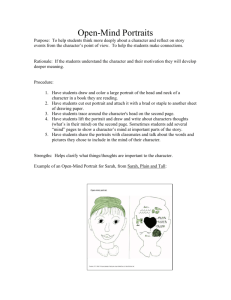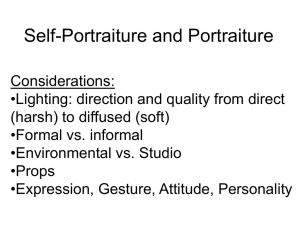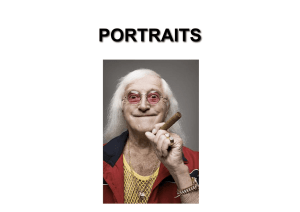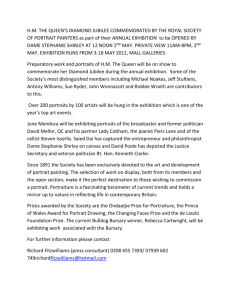Document 10999826
advertisement
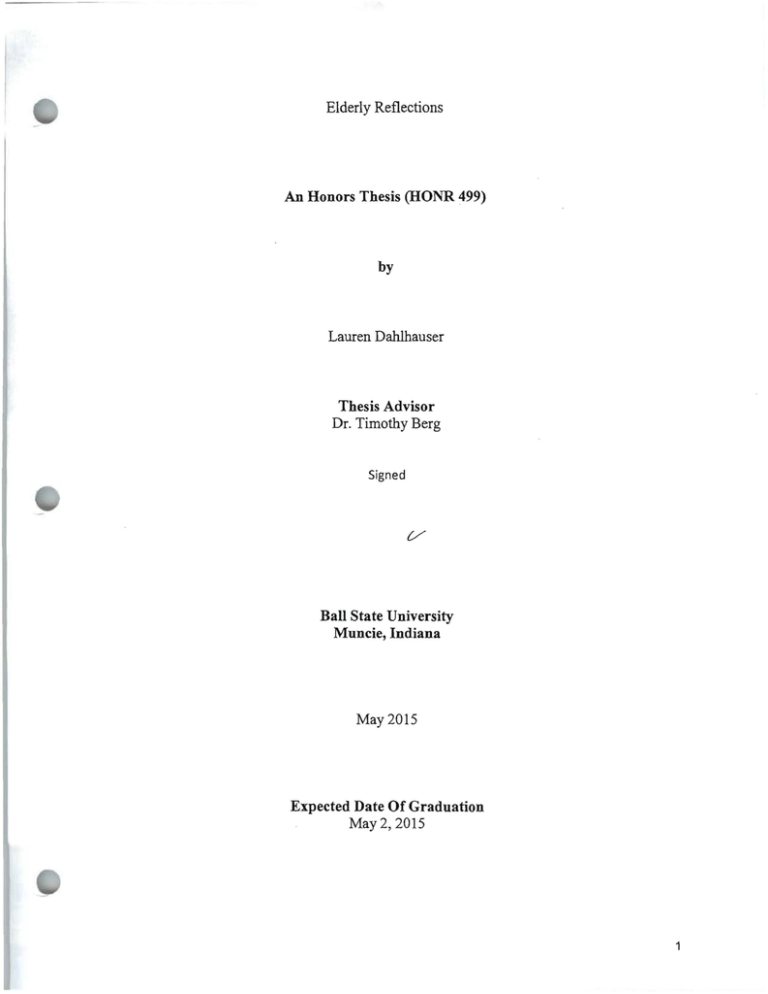
Elderly Reflections An Honors Thesis (HONR 499) by Lauren Dahlhauser Thesis Advisor Dr. Timothy Berg Signed Ball State University Muncie, Indiana May 2015 Expected Date Of Graduation May 2, 2015 1 Acknowledgements I would like to thank my professor, Dr. Timothy Berg for guiding me throughout the semester on this project. His passion for photography and encouragement for me to grow outside of my comfort zone were two catalysts to the success of this thesis. I would also like to thank the staff and residents of Willowbehd Living Center in Muncie, Indiana. Without the residents of Willowbend, I would not have been able to carry through with this project. I would like to thank Paula Simmerman, Activities Coordinator at Willowbend, specifically for her help and kindness. Abstract Two major aspects of photojournalism are seeking out a story and utilizing various storytelling skills to execute it well. Photojournalists are able to tell stories or get across ideas not only through photography, but also through text, video, and audio. These mediwns can be combined in a variety of ways to tell a specific story most efficiently. Photojournalists practice and build on good people skills, technical skills, and storytelling skills throughout their careers. Although I have had little time to take on big photojournalism projects outside of what I'm limited to at Ball State University, I wanted to branch out into the community to a specific age group. I am intrigued by old age, wisdom, and perspectives. Since I have little experience interviewing older age groups, I limited my subjects to people who were above the age of75. I strengthened skills and built on new ones by doing a photographic portrait project. I created portraits of people and paired them with quotes to make a book as a final product. 2 Acknowledgements I would like to thank my professor Timothy Berg for guiding me throughout the semester on this project. His passion for photography and encouragement for me to grow outside of my comfort zone were two catalysts to the success of this thesis. I would also like to thank the staff and residents of Willowbend Living Center in Muncie, Indiana. Without the residents of Willowbend, I would not have been able to carry through with this project. I would like to thank Paula Simmerman, Activities Coordinator at Willowbend, specifically for her help and kindness. 3 Author's Statement An Introduction There are countless stories to be told within the cities and countries that make up this world. There is a beauty in being able to tell these stories through writing, photography, video, or any other avenue a storyteller decides to take. We are all storytellers to a certain degree, always trying to capture our lives through photographs and social media. We are always communicating with one another about our lives too, but still, so many stories go untold. As a result, there is a huge art in seeking out these stories and being able to tell them through the eyes of a photographer and journalist. I am passionate about finding these stories and telling them in a way I see fit according to the skills and education I have developed and gained through my personal endeavors as an artist and four years of education as a photojournalist at Ball State University. My main goal for this project was to create something that allowed me to use what I am most passionate about to drive me while pushing myself out of my comfort zone. This resulted in a desire to take on a portrait project. I wanted to not only grow as a photographer, but also as a journalist. I chose to interview around ten subjects over the age of 75 about big life lessons they'd learned and what their perspective is on youth and wisdom. The end product would be a compilation of dramatic black and white portraits paired with moving quotes from each subject. A project like this would not only allow me to demonstrate my photography and portrait skills, but it would also allow me to improve my interviewing skills and practice design skills in the form of combining text with photos. 4 Why Certain Decisions Were Made I created a book of quotes paired with portraits. Although I had free reign to interview whomever I wanted for this project, I specifically chose the age group I did because I have little experiencing working with the elderly. I have collaborated on many stories and projects during my time as a photojournalism major at Ball State University, but the majority of the sources and subjects involved were my age or slightly older. Working with teenagers and young adults is much different than working with children or, at the other extreme, the elderly. Before I set out to begin the interview process, I limited subjects to people above the age of 75. I considered a variety of ways I could reach out to the age group I desired, but I settled on contacting a couple of nursing homes. Access to residents would be much easier since so many live within a small proximity and it would save me multiple trips to various homes. I got in touch with the activities director at Willowbend Living Center who was gracious enough to help me compile a list of potential interviewees. Since she knew many ofthe residents personally, it was easy for her to figure out which ones might be good sources. She spoke to many of them to get permission and in no time I was set up with around ten potential subjects. The other benefit of choosing a nursing home in my eyes was a stronger connection to the Muncie corrununity. Working with the staff and residents of Willowbend is what allowed me to branch outside of the university and get outside of my comfort zone like I had wanted to do. I prepared interview questions that would result in answers to lessons learned through many years of experience and wisdom gained. The perspective of someone who has lived so much longer than I has always intrigued me. I wanted the book to be unified in more ways than a collection of portraits. I wanted all of the quotes to be somewhat related as well. 5 I chose to execute my thesis in the fonn of a book for a couple reasons. Putting together a book allows me to create something tangible. For someone who works so much with digital images, I actually prefer something you can hold and flip through. I am a hands-on, creative person with a background in art, so I love to create tangible projects. Throughout my college career I have had little opportunity to create art projects so this is why I wanted to make a book. For the portraits I took of each subject, I settled on a unified black and white look. I took close-up headshots of each person and changed each image to black and white because I felt it brought more focus to their eyes and emphasized the emotions that were coming across from their facial expressions and gaze. I wanted to bring out the texture in each face as well to show their age and add to the dramatic affect. Inspired by photographer Richard A vedon, I chose to photograph each subject with my own lighting set up against a plain white wall. I chose this portrait method because I am not used to photographing people under modified light conditions and I wanted to create portraits with no distractions in the background. 6 Goals and Challenges As with any big project like this, I faced some challenges that forced me to reconsider a few things and readjust the original goals I had set for the project. The biggest challenge I faced was getting the desired answers to my questions. I think with a younger age group, I would have come out of the process with better results; but with residents in a nursing home this old, many have difficulty remembering, speaking, or hearing. After explaining my project thoroughly to each resident, many still seems somewhat confused about why I wanted to get their perspective on young people today. When I stumbled into issues of getting directed answers, I had to learn to continue the conversation so that I would at least have something to pair with each resident's portrait. I learned how important it is to be silent at times when they stopped talking. Although I wanted more than anything to fill the silence at any point in time they stopped talking or became unsure of what to say, I learned to hold my tongue. I learned patience and determination throughout the fifteen interviews I conducted. My original goal for the project was to have a minimum of 15 to 20 quotes and portraits in my book. In the end, after having difficulty getting the answers I wanted, I decided that quality over quantity was the best route. I included 10 of the elderly I interviewed in my book. I was not disappointed that I didn't meet my original goal of including 15 to 20 quotes. It was neat to have more time to interview fewer people and to get a pool of quotes I wasn't expecting. My book wasn't unified in theme, but it was unified through the portraits and the age group I interviewed. Although I feel the portraits turned out decently well, it was a challenging process to photograph each of the interviewees. Photography, in ajowllalism sense, can be a seemingly invasive practice. Most people do not feel comfortable in front of a camera. It is not often that one has to sit in front of a camera to be photographed so closely. I could definitely sense 7 discomfort from the majority of the elderly I photographed. Most hadn't had their picture taken in a long while. Although most had originally given permission to be photographed to the activities director at Willowbend, when it came time to take their picture there was resistance. Most did not want to smile or felt insecure about the way that they looked. Sensing these feelings from them made it difficult for me to be at ease while photographing them. It reminded me of a concept I'd learned from the ,film Richard Avedon: Darkness and Light I watched in a photography colloquium I'm currently taking. The portrait process comes down to the concept of giving and taking. The end result is a combination of what the subject gives to the photographer and what the photographer takes from the subject. It is an interactive process that requires a silent, and sometimes verbal, dialogue between the subject and photographer. 8 The Process Between the photographing and interviewing, I found the interviewing to be the more challenging process. I dove into the project with expectations of answers I wanted to walk away with. It was not as easy as I thought it would be to have a back and forth conversation with the subjects. I think a huge hindrance was the major gap in age. The rest of it was me learning when to be silent orhow to direct the interview when I wasn't getting the answers I wanted. All of the interviews I conducted were one on one interviews in a private room in the nursing home. This was a good option for quality audio, but it did make the interviewees more uncomfortable. As much as I could, I attempted to interview each person in his or her own room so each would feel more at ease and at home. I took each person's portrait directly after I interviewed him or her. I chose this order because I wanted them to be as comfortable with me as possible. When a subject is more comfortable with the photographer, a more genuine portrait can result. Despite the order in which I chose to interview and photograph, it still wasn't quite enough to put any of them at ease. Each interview lasted approximately 15 minutes to a half hour. I think had I conducted mUltiple interviews with each one and had more time to develop a stronger relationship with each person, it would have been less awkward to photograph each individual. Each portrait was lit with one light. After the interviews, I turned out the lights in the room and set up a lamp on a nearby dresser or table. I did my best to place it at eye level with each subject and angled it about 45 degrees from their face to get what's called "Rembrandt lighting", a look reminiscent of the Dutch artist's paintings. I used one light because I wanted to bring out the texture in each subject's face. This also created a bolder, more dramatic portrait with high contrast. I chose to make each photo black and white to simplify and bring attention to 9 the person's eyes and face. I looked to Avedon for a lot of my inspiration, hence the close up portrait with a plain white background, a style A vedon was well known for. Avedon's photography style appeals to me because it so different from my own. Avedon is well known for his studio work. Photographing subjects against a plain white background became one of his signature setups. I wanted to replicate this simple, authentic look so that I could practice lighting my subjects while creating portraits where there is nothing to focus on but facial expression. I wanted the people I photographed to tell their own story with their eyes in a sense. 10 Lessons Learned Through this project I grew both as a professional and as a photojournalist. Professionally, I was faced with opportunities to directly engage in the community. I carried myself as a professional throughout the interview process and photography process. My communication skills were utilized and strengthened and, more specifically, my interview skills were stretched. In the future if I decide to pursue a career in photojournalism, strong communication, writing, and people skills will be necessary in addition to technical skills as a photographer. I was also able to practice controlling lighting. I tend to lean toward natural light as a light source for my portraits, but it was beneficial to practice setting up each portrait individually. It was a lot of trial an error the first few times I placed the light and set my camera to attempt getting "the perfect" portrait. After a few portraits, setting up the lighting became a much quicker and efficient process. One huge benefit of taking on this project with controlled lighting and the elderly is that it will succeed in diversifying my portfolio. This project allowed me to display a wider range of subjects and demonstrate a wider range of technical skills as well. Diversity is an important aspect to journalism and photography. This project allowed me to demonstrate my skills beyond natural lighting. It showed that I am capable of designing, working with people, and photographing. It is a project I may continue further down the road. 11 ELDERLY REFLECTIONS A Portrait Project By Lauren Dahlhauser VERA CRAYCRAFT Age: 75 "Wisdom comes in many different ways . There's wisdom, like being intelligent. Then there's the kind of wisdom you gain from learning. I learned through travel. I was thankful to be able to do it. It's something I'll always remember. II FLORA MORRIS Age: 90 liMy advice to young people would be to be good and stay happy. After a while, happiness just comes to YOU." CAROL BINGHAM Age: 82 "When [my family] wants something they always come to Grandma and Grandma's gotta give it to them. If I don't have it they say, 'Why?', and I say, 'Well it's just one of those things! You're growing up to go out and make some money. You're not supposed to come to Grandma all the time and ask for money. When you grow up, you get yourself a job and you work!'" EVERETT GODSEY Age: 74 "If I can treat people the way I want to be treated and lay down that night and sleep and don't have anything to worry about, I'm a very rich person. I don't have any money, but that's not everything in this life. I sold my house and my car and I moved in here and that's the best thing I ever did." IRENE HOLT Age: 85 "Mom and Dad, I haven't forgotten them. I never will. Some people you say that to and they look at you like they think you're nuts. They've never had the feeling of really loving someone I guess. II ROBERTA CLEVENGER Age: 80 "When you're young you love to learn. When you get older, it's still fun to learn more." ROSEMARY LARE Age: 77 "I would do it allover again if I could. There are so many things that I missed out on that I could have done if I would have but I didn't. I didn't have the time. I had three children to raise after a divorce and I didn't have the money. I wish I would have checked out all the opportunities life had to offer. I didn't try hard enough." STANLEY MATTHEWS Age: 82 "My biggest fear is how the world is with all these different countries. It'd be nice if they all got along. They never have gotten along." SHIRLEY GULLETT Age: 79 "I was born with a family of thirteen but I was only raised with one of them. My mother was dying with cancer. If my foster mother hadn't raised me, I'd probably be dead because I probably would have starved to death. She was good to me. She said if I wanted to go on a date or anything like that, I had to go to church. *Iaughs* I don't know why because she really didn't go to church that much herself!" DOROTHY PETERSON Age: 92 "I can't say I'm happy here, but God knows what's best. He has spared me, kept me from going the wrong way, and I'm eternally grateful for that. God is so good. I am so grateful to be a part of his family. I can only hope to see Grandpa and my family hopefully in Heaven."
